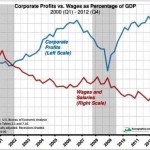Moderate Republicans (How did we end up in this vale of tears?)
Thursday, May 12th, 2016
| It’s been a bleak election season for moderate Republicans — I know because I’m one of them, and I’ve been commiserating for months with like-minded centrists.
I used to think that we (moderate Republicans) comprised the base of our party. All the wackiness of the presidential primaries and caucuses was mere grandstanding, designed to placate the small Evangelical and Tea Party factions of the party’s base in early primary states such as Iowa and South Carolina. But once the silly season was over, I felt we could count on nominating a solid citizen as our candidate for President. This confidence was not based on naiveté but on a stellar record; we did it in 1979 with Ronald Reagan, a brilliant visionary and an adept pragmatist who knew how to work both sides of the aisle, and most recently, with Mitt Romney, a less-than-natural campaigner but an honorable man with vast talent who had been a successful governor of the most Democratic state in the Union. But this year has turned out to be downright depressing, as we witness a modern day “Luddite” spout vitriol and diatribes against anyone who doesn’t pay him the respect he craves but can’t earn. Moderate Republicans are so mainstream that some people mistake us for moderate Democrats. I like that because what we have in common is our moderation. We are more alike than either of us is relative to the far reaches of our respective parties. I tend to think that together we represent a significant majority of voters in the American electorate —in effect, the vast silent majority. Moderate Republicans believe that government is necessary but should not be overwhelming — and never intrusive. We believe the government needs to stay out of the bedroom and out of the doctor’s office. Moderate Republicans realize that government is not the solution to all problems; we know that it’s the private sector that generates profits, and profits are what’s needed for both economic growth and individual wealth creation. So, limited government is essential, and regulation should aim to support, not stymie, free-market behavior. Moderate Republicans respect science and are committed to the responsible stewardship of our planet. Our leaders were the instigators of public discourse about air and water quality, which was the genesis of the Environmental Protection Agency, and they played a key role in the mitigation of acid rain from the Midwest to the Northeast. But they also acknowledge that onerous and excessive regulation that does not take into account legitimate cost benefit analysis is deleterious for the well-being of the country. Moderate Republicans believe that a minimum wage that keeps a head of household below the poverty level is a hindrance to economic growth, and that it’s also morally deficient. Moderate Republicans support immigration reform, abhorring the notion of deporting millions of workers, the vast majority of whom pay income and Social Security taxes, contribute to our economic growth and, in many cases, bear the pain of separation from their loved ones thousands of miles away in order to support them. They also believe that our borders need to be more open to the many around the world who want to benefit from the opportunities this country offers to those who are willing to work hard to improve their chance of a better life. Moderate Republicans make an effort to educate themselves on social issues that have a bearing on the lives of those who might be victims of discrimination, prejudice and retaliation. They respect diversity and support a social order that allows human beings to lead their lives without fear. (And, yes, moderate Republicans believe that gender police should stay out of the bathroom!) Moderate Republicans find abhorrent the notion of our nation defaulting on its debt because a government that would not honor its financial obligations is the moral equivalent of a government run amok. That’s what happens in failing states in the third world, not in the most powerful nation on the planet. Moderate Republicans believe that the Second Amendment was written during a time when our newly formed country had to be defended by a ready citizen militia, and that the right to bear arms should not stand in the way of government regulation to ensure the safety of the population at large. Moderate Republicans believe that their president should show leadership by actively embracing members of the opposite party, building respect and having the courage and integrity to compromise when it’s in the best interest of the country. These are but a few of the many ways moderate Republicans think about the issues facing our country today. Sadly, we have no candidate who represents our values. We are left holding our noses (as an Italian friend of mine said she would do when voting for Berlusconi) on election day and voting for whomever we think is the lesser of two bad choices. And, dear Democratic friends, I’m already anticipating your invitations to join your party. But I can’t — I am a true and tried moderate Republican and proud of it. © Copyright 2016 Patricia W. Chadwick |

 (0 new)
(0 new)